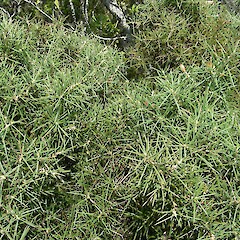Hakea sericea
Common name
prickly hakea
Family
Proteaceae
Flora category
Vascular – Exotic
Structural class
Trees & Shrubs - Dicotyledons
NVS code
The National Vegetation Survey (NVS) Databank is a physical archive and electronic databank containing records of over 94,000 vegetation survey plots - including data from over 19,000 permanent plots. NVS maintains a standard set of species code abbreviations that correspond to standard scientific plant names from the Ngä Tipu o Aotearoa - New Zealand Plants database.
HAKSER
Conservation status
Not applicable
Habitat
Terrestrial. A coastal and lowland plant (Timmins & MacKenzie 1995). The plant grows in low fertility sites (Timmins & MacKenzie 1995). A plant of low forest, scrub and forest margin and shrubland (Timmins & MacKenzie 1995).
Wetland plant indicator status rating
Information derived from the revised national wetland plant list prepared to assist councils in delineating and monitoring wetlands (Clarkson et al., 2021 Manaaki Whenua – Landcare Research Contract Report LC3975 for Hawke’s Bay Regional Council). The national plant list categorises plants by the extent to which they are found in wetlands and not ‘drylands’. The indicator status ratings are OBL (obligate wetland), FACW (facultative wetland), FAC (facultative), FACU (facultative upland), and UPL (obligate upland). If you have suggestions for the Wetland Indicator Status Rating, please contact: [Enable JavaScript to view protected content]
FACU: Facultative Upland
Occasionally is a hydrophyte but usually occurs in uplands (non-wetlands).
Detailed description
Large spreading shrub or small tree. Shoots densely hairy, somewhat angular. Leaves terete, simple, 20~60 x .7~1mm, glabrous except when very young, rigid and spiny. Flowers few, in fascicles of less than 10; peduncles 0 or very short, densely hairy. Pedicels 3~4mm long, densely hairy to glabrate. Perianth white, glabrous, = pedicels. Ovary shortly stipitate or sessile; style glabrous; stigma cone slightly oblique. Fruit 2~3 x 1.4~2.5cm, mostly very corrugated; beak very short. Seed 15~25 x 6~12mm (incl. wing), black; wing extending down one side. (- Webb et. al., 1988)
Similar taxa
Large, prickly, spreading shrub or small tree. shoots densely hairy, older plant without hair. Leaves circular in cross section. Large seed capsule beaked and woody with a seed winged on one margin. Flowers June-November. Can be confused with downy hakea - note the downy hakea plant is covered in hair (DoC, 1998)
Flowering
June, July, August, September, October, November
Flower colours
White, Yellow
Life cycle
Perennial. Germination of seeds is high on burnt sites (Timmins & MacKenzie 1995). Seeds are released from trees and either germinate or decay (Timmins & MacKenzie 1995). The plant does not establish below its own canopy (Timmins & MacKenzie 1995). Seed production is abundant, and seed remain viable on trees , dispersed by gravity and wind ((ibid.).
Year naturalised
1883
Origin
Tasmania, E Australia
Reason for introduction
Ornamental
Tolerances
The plant is slightly tolerant of shade and frost; highly tolerant to drought and intolerant to poor drainage (Timmins & MacKenzie 1995). Resprouting does not occur from the base, but once toppled, can revert to vertical shoot growth at ends of branches (Timmins & MacKenzie 1995). Adult plants are killed by fire, but releases seed (Timmins & MacKenzie 1995). Requires low soil fertility (Atkinson 1997).








